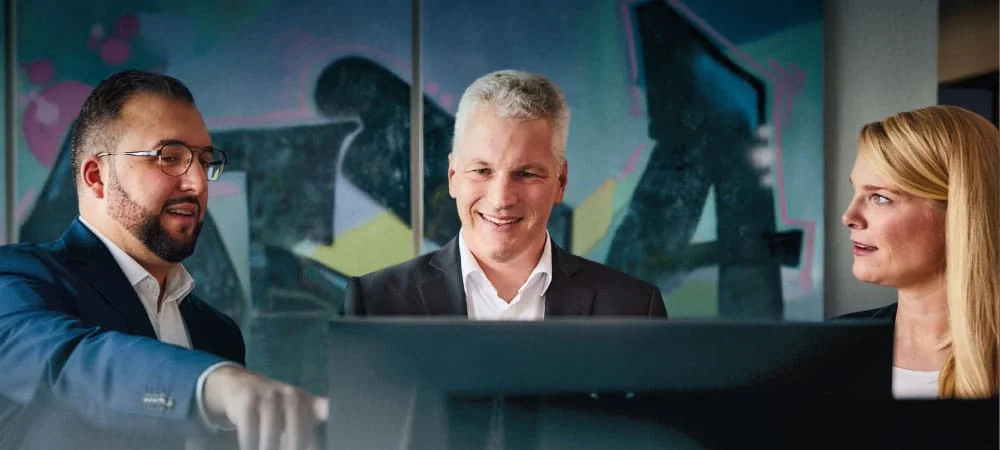Standard for digital merchandising


In an article, Forbes calls your tool a "futuristic shopping solution". What exactly does Indigo Media do?
Guillaume Waline: At Indigo, we believe that e-commerce has changed the shopping dynamic forever. Online shopping offers many unbeatable benefits that allow customers to shop easier and faster than ever before, while the in-store shopping experience has remained unchanged for decades.
In this new digital era, customer demands have also evolved and retailers are now faced with very demanding customers.
Retailers need to recognize that it is necessary to polish the in-store shopping experience in order to remain competitive. At Indigo, our goal is to make the in-store shopping experience as easy and effortless as it is on a website.
As a customer, consider the following:
- How often have you left a store dissatisfied because you didn't find what you were looking for?
- How often have you decided not to buy a product because you didn't have the right information?
- How often have you wished for an undisturbed and effortless shopping experience without having to wait for a sales assistant?
In the next generation of stores, all these problems will be overcome. The Indigo "Connected Retail" solution uses the SAP Cloud Platform and the IoT to develop a new generation of responsive stores.
Our application provides an innovative shopper experience and enables retailers to collect customer information to deliver advanced marketing analytics in-store.
The solution provides a store sensing analytics system that works in real time for retailers and integrates with multiple third-party operational solutions.
How did SAP support you with the go-to-market?
Waline: Our solution was validated by the SAP Startup Focus program in June 2016, and since then the go-to-market team has contributed a great deal to our success.
As a start-up, we benefit from the agility of our small team, but as we have the ambition to grow and scale in the future, we need to pursue a more structured go-to-market strategy in order to continue to meet the demand of our customers with complete satisfaction.
Working with Startup Focus has given us the opportunity to meet the right contacts in the retail industry. It was the first time our solution was put to the test in real situations, which helped us to better adapt our product to our customers' problems and reassess the size of the market.
One of the main obstacles was that we had focused too much on the technical aspects of our solution - as is often the case in digital business - as we assumed that the industry would understand the potential of a technical solution.
This is a mistake that can quickly become a start-up's undoing. By working with Luisa Silva (Global Director of GTM at SAP Startup Focus) and our marketing team, we were able to accelerate our time to market. We focused on the value of data and insights into buying behavior for our customers.
Startup Focus has helped us enormously in developing our go-to-market strategy and utilizing our technology properly. Together with the SAP Cloud Platform, this has been a strong lever for our growth.
Why did you choose Hana for the implementation of your solution?
Waline: Our business model is based on the commercial use of our solution, so we had to use a highly scalable platform with a high level of reliability.
Initially, our developers were skeptical about the Hana database, but when they compared it to others, they immediately adopted Hana. Now they can no longer imagine using any other solution.
We collect immense amounts of data, each of our newly delivered systems sends thousands of queries to our database every day, and the number of systems in use is growing ever faster.
Hana can rise to this challenge and we are confident that Hana can keep up with our growth. Although we use many services (database, API engine, media server, document storage and more) for our product, we don't have to worry about maintaining this ecosystem because SAP does it for us!
Building our technology natively on the SAP Cloud Platform allowed us to focus on the essentials: developing our solution and putting energy into our product.
There are also strategic reasons for using the SAP Cloud Platform and Hana Database. Before we came to Startup Focus, we heard that the SAP Leonardo ecosystem was being released. Today, we use almost all aspects of SAP Leonardo - with the exception of blockchain, which we will also use in the near future.
Some of our functions require a connection to our customers' ERP system, so SAP Hana seemed logical for two reasons.
In the article mentioned above, you call the traditional store a big "black box" for retailers. How do you help your customers to look inside this box?
Waline: At Indigo Connected Retail, we believe that the business is a black box, as retailers have very little insight into what really happens in-store when customers select and buy products.
Most retailers know how many people come into the store (traffic) and how many products are sold - but nothing more.
What about the attractiveness of the product for the customer? Do they know how many sales they have lost in a single day? And do they know why they are losing sales?
Instead of a black box, stores have the potential to be a real medium, an interactive medium that provides shoppers with experiences similar to those found online.
In order to adapt merchandising in real time and offer customers the shopping experience they are really looking for, retailers need to know exactly what the customer is thinking when they are in front of the product.
With the right resources and technology, retailers can understand why, even though a customer is more interested in product X than product Z, they end up buying product Z. Why is this the case: is the price too high, does the packaging not match the brand image?
With our solution, you can build marketing engagement so that the KPIs track the buyer insights you need to increase your sales.
How do you obtain the necessary data?
Waline: To provide such a seamless shopping experience, we have developed a new way of interacting: We are turning the entire store into an interactive space by using the IoT.
This is integrated into the entire shopping area, especially in product displays. The main strength of our platform is that we can use a wide range of IoT, even third-party technologies.
Thanks to our architecture, we can integrate any device into our system. To provide a unique experience, we use two types of IoT: sensors and actuators.
Sensors recognize an interaction and actuators deliver the experience. Sensors can be cameras with image recognition algorithms, capacitive sensors that make almost any material (wood, plastic, cardboard) interactive, light detection, presence detection, beacons, fidelity cards and even mobile apps or web apps.
Actuators include screens, lights (any kind of flashing system), scent dispensers, sounds, even servo motors; of course, these can also interact with mobile apps.
What technical requirements do your customers need to fulfill?
Waline: There are no specific customer requirements other than an internet connection within the store to collect the data and update the experience.
We can integrate our solution into any point-of-sale display. Our solution is very agile and fits into existing or new furniture - we don't build furniture ourselves.
Our solution was developed natively on the SAP Cloud Platform, but does not require an SAP system. Thanks to a powerful API, we can work with customers using any ERP and marketing technology.
When a customer uses your platform for the first time, how long does it take to see the first results?
Waline: In our experience, retailers need at least six months to collect enough data from a single marketing campaign to provide consistent data for business intelligence analysis.
Once the data is collected, marketing and predictive models are created and the experience can then be customized to meet the customer's expectations. Our solution enables real-time merchandising, allowing retailers to respond very quickly.
What are your plans for the near future and how does the Startup Focus program support you?
Waline: Our technology has been on the market since December 2016 and after a year we have received good feedback from our customers, this has helped us to improve our services.
The next step is to scale to make Indigo C-Retail the standard for digital merchandising and big data for retailers. To achieve this, we need to accelerate our time to market, increase our integration with retailers' ERP systems and also focus on data analytics.
As a member of the Startup Focus program, we can regularly participate in SAP events where we meet SAP sales teams and customers.
This enables us to better understand and get to know our customers and their pain points, which is a critical success factor for our market launch. It also gives us the opportunity to educate retailers and brands about the benefits of big data.





